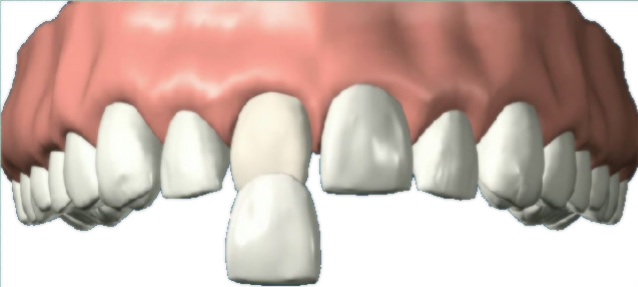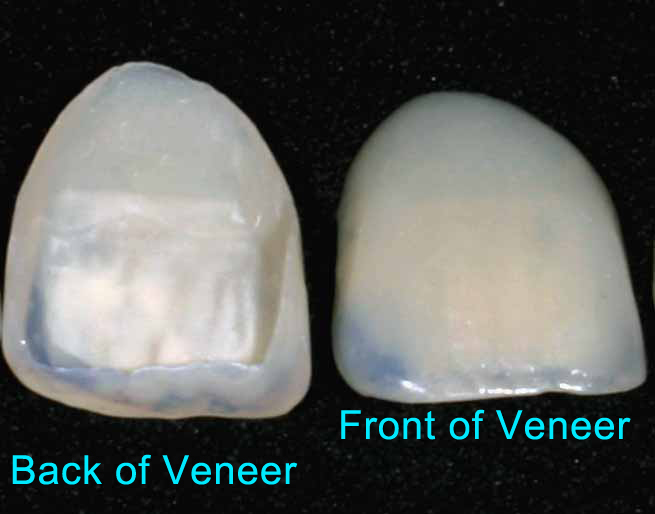You don't have to wear teeth brace just because of the 1 tooth!! Wearing teeth brace is very hurt and it is expensive cost around RM3000.
What we need to do is do Veneers Composite or Composite Bonding. It cost around RM90 for 1 tooth. The dentist will use glue stick an extra layer of plastic on top of your tooth, you won't feel any pain, won't bleeding too and it took only 5 minutes to get it done!!! So when you are smiling, people will see the plastic and cannot see your ugly teeth. It is like you are wearing a fake finger nail. You are wearing a fake tooth, the fake tooth is call Veneer. There are many different sizes and many different colors of veneers to fit on your real teeth. The picture below shows the Veneers Composite that put on the front of your tooth :



What are Veneers?
Veneering a tooth means to cover its facial or front surface. It is actually very similar to placing acrylic fingernails on top of natural nails except they are permanently in place. Veneers are used to enhance shapes and colours of teeth as well as to close spaces between teeth and to cover up significant stains such as those caused by tetracycline. It can also be used to repair chipped or broken teeth or even to cover up unsightly stains. They can also improve the alignment of your teeth to even out an uneven smile. They require only minimal reduction of the tooth surface so they are a more conservative treatment than crowns.
What is the difference between a Porcelain and a Composite Veneer?
There are two types of veneers: Porcelain and Composite. A Porcelain veneer is stronger, resists staining and reflects light. They are among the most natural looking restorations available. Porcelain veneers can be used in place of crowns for a more conservative and natural looking smile.
A Composite veneer is quicker and cheaper but is not quite as aesthetic or long lasting.
What does a Porcelain Veneer involve?
During the first visit, a local anaesthetic is used and the tooth or teeth are reduced by approximately 0.5mm – 2.0mm. An impression is then taken and sent to a dental ceramicist for fabrication which usually takes one to two weeks. A temporary restoration may be necessary and there may be slight sensitivity to hot and cold during this period.
At the second visit, a local anaesthetic may be used in seating the veneers. After thoroughly cleaning and preparing the teeth, the veneers are placed with a resin material and cured or hardened with a special curing light.
What does a Composite Veneer involve?
Composite veneers only require a single visit. Unlike porcelain veneers, composite veneers require only minimal or no tooth reduction thus making it a very conservative procedure. It usually requires no anaesthetic. Composite veneers can be touched up and even re-bonded over time as necessary.
How long will Veneers last?
Composite and porcelain veneers should last between 5 and 10 years depending on proper care and maintenance and can often last longer. Porcelain veneers resist staining, reflect light and are among the strongest and most natural looking restorations available.
Note : I recommend you do Composite Veneer, because it is fast (it can be done in 5 minutes), no pain, no bleeding. It cost me RM90 per tooth in Penang in Malaysia. The doctor asked me don't bite the steak or meat too hard and don't chew the meat too hard with your tooth, don't brush your tooth too hard too because worry the veneer/plastic will fall off. If it is fall off, I need to waste another RM90 to do another new veneer composite on my tooth, haha. Anyway, I didn't listen to the doctor's advice, I just chew and bite the steak/meat, brush my teeth very hard and the veneer still didn't fall off. I wearing the veneer for more than 2 years already, It won't fall off, so don't worry. I guess now every dental clinics also have offer Composite Veneer service.

Teeth veneers provide a longer lasting solution to teeth whitening, however they are the most expensive option, the effect can last for up to 10 years. The technique works but bonding a strong material to the front of the teeth, either a composite material can be used for teeth bonding or a veneer can be used. Composite bonding is generally cheaper than veneer bonding.
Composite teeth bonding
The procedure is as follows, the front of the tooth is warn away so that the new tooth will be of a similar size to the current tooth, then minute grooves are etched onto the surface with a weak acid. Then a composite resin with a suitable color match is place on the teeth. It is moulded onto the teeth and set hard by a light. The final stage is a polish and a smooth.
Teeth veneer bonding
A veneer is created which is the required form to match your mouth and teeth. The strongest and most desired veneers are made from porcelain. The dentist will take an impression of all the teeth, this is then sent away so that the veneer can be created. The front of the teeth is reduced in a similar fashion as with composite tooth bonding. Once the veneers are ready they are bonded to the teeth using a bonding cement.
Porcelain is a glass like ceramic, it is ideal as it matches very closely to the natural color of a tooth. This is due in part to the fact that porcelain is translucent much like a real tooth. This means that light penetrates the veneer and reflects of the underlying dentin. Veneers can also be used to cover underlying problems with teeth such as chipping and cracking.
Veneers Composite and Composite Bonding can solve a lot of teeth problems such as yellow teeth, broken teeth, space between teeth and so on. Pictures below show before and after doing Veneers Composite and Composite Bonding:
More information:
Veneers:
Veneers are thin, semi-translucent “shells” typically attached to your front teeth. Veneers are customized from porcelain material and permanently bonded to your teeth. Veneers are a great alternative to otherwise painful dental procedures to improve the appearance of your smile.
Common problems that veneers are used for:
* Spaces between the teeth
* Broken or chipped teeth]
* Unsightly, stained or discolored teeth
* Permanently stained or discolored teeth
* Crooked or misshapen teeth
Veneers are a great aesthetic solution to your smile that may even help you avoid orthodontic treatment.
Composite Bonding:
Bonding is a common solution for:
* Fixing or repairing chipped or cracked teeth
* Reducing unsightly gaps or spaces between teeth
* Hiding discoloration or faded areas on the tooth’s surface
* Often used to improve the appearance of your teeth and enhance your smile. As the name indicates, composite material, either a plastic or resin, is bonded to an existing tooth. Unlike veneers or crowns, composite bonding removes little, if any, of the original tooth.
Composite bonding has many advantages:
* It is a quick process, which typically lasts less than one hour.
* It does not reduce the tooth’s original structure and is relatively inexpensive.
* Composite resins come in many different shades and provide better matching of shades to the natural color of your teeth.
* Composite bonds, however, are not as durable and long-lasting as veneers and crowns and may need to be re-touched or replaced in the future.
* Composite bonds stain more easily and therefore require proper care and regular cleaning. In order to ensure the longest possible duration of the bonding, composites should be brushed and flossed daily. Common staining elements include coffee, tea, tobacco, foods and candy.






Tidak ada komentar:
Posting Komentar